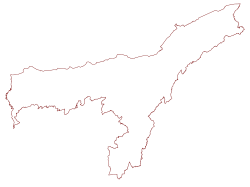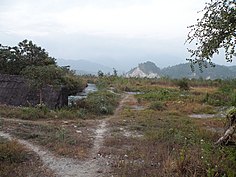Gethsemane Man-made Forest: Difference between revisions
>The Anomebot2 (Adding geodata: {{coord missing|India}}) |
m (robot: Update article (please report if you notice any mistake or error in this edit)) |
||
| Line 14: | Line 14: | ||
The man-made forest now has over 14 lakh plants such as khoir, gomari, simul, shisham etc. Many wild animals have returned to the forest.<ref>{{Cite web|title=Barren forest land regenerated at Bhairabkunda|url=http://www.assamtribune.com/scripts/detailsnew.asp?id=dec2511/at092|access-date=2020-12-04|website=The Assam Tribune Online}}</ref> Animals such as elephant, leopard, wild boar, tiger, deer, etc. and reptiles such as paradise flying snake and python are found in the forest.<ref>{{Cite web|date=2016-07-20|title=Man-made forest at Bhairabkunda|url=https://assamtimes.org/node/17310|access-date=2020-12-04|website=Assam Times|language=en}}</ref><ref>{{Cite web|date=2016-04-03|title=Flying snake found at Bhairabkunda|url=https://www.assamtimes.org/node/16643|access-date=2020-12-04|website=Assam Times|language=en}}</ref> The Lepidiota Mansueta beetle specie is also commonly found in the forest along with various species of butterflies and dragonflies. It is also home to various himalayan, native and migratory birds.<ref>{{Cite web|date=2017-12-25|title=Afforestation changes life and landscape: How a district in Assam lost a forest, gained a future|url=https://indianexpress.com/article/india/afforestation-changes-life-and-landscape-how-a-district-in-assam-lost-a-forest-gained-a-future-4997615/|access-date=2020-12-04|website=The Indian Express|language=en}}</ref> The emergence of forest has also contributed towards the reduction of man-elephant conflict in the area.<ref>{{Cite web|title=Regenerated Bhairabkunda forest easing human-elephant conflict|url=http://www.assamtribune.com/scripts/detailsnew.asp?id=dec2018/at061|access-date=2020-12-04|website=The Assam Tribune Online}}</ref> | The man-made forest now has over 14 lakh plants such as khoir, gomari, simul, shisham etc. Many wild animals have returned to the forest.<ref>{{Cite web|title=Barren forest land regenerated at Bhairabkunda|url=http://www.assamtribune.com/scripts/detailsnew.asp?id=dec2511/at092|access-date=2020-12-04|website=The Assam Tribune Online}}</ref> Animals such as elephant, leopard, wild boar, tiger, deer, etc. and reptiles such as paradise flying snake and python are found in the forest.<ref>{{Cite web|date=2016-07-20|title=Man-made forest at Bhairabkunda|url=https://assamtimes.org/node/17310|access-date=2020-12-04|website=Assam Times|language=en}}</ref><ref>{{Cite web|date=2016-04-03|title=Flying snake found at Bhairabkunda|url=https://www.assamtimes.org/node/16643|access-date=2020-12-04|website=Assam Times|language=en}}</ref> The Lepidiota Mansueta beetle specie is also commonly found in the forest along with various species of butterflies and dragonflies. It is also home to various himalayan, native and migratory birds.<ref>{{Cite web|date=2017-12-25|title=Afforestation changes life and landscape: How a district in Assam lost a forest, gained a future|url=https://indianexpress.com/article/india/afforestation-changes-life-and-landscape-how-a-district-in-assam-lost-a-forest-gained-a-future-4997615/|access-date=2020-12-04|website=The Indian Express|language=en}}</ref> The emergence of forest has also contributed towards the reduction of man-elephant conflict in the area.<ref>{{Cite web|title=Regenerated Bhairabkunda forest easing human-elephant conflict|url=http://www.assamtribune.com/scripts/detailsnew.asp?id=dec2018/at061|access-date=2020-12-04|website=The Assam Tribune Online}}</ref> | ||
[[File:Ariel View of Gethsemanene Man-made forest.jpg|left|thumb|293x293px| | [[File:Ariel View of Gethsemanene Man-made forest.jpg|left|thumb|293x293px|Aerial view of Gethsemane man-made forest]] | ||
== Eco-Tourism == | == Eco-Tourism == | ||
The forest is growing as | The forest is growing as an eco-tourism destination in the region. Thus helping local communities in the process. It has many trekking trails as well as cycling strips for adventure sports enthusiasts. | ||
== Geography == | == Geography == | ||
| Line 51: | Line 51: | ||
* [https://getsemaniforest.wordpress.com/2018/11/22/flying-snakes-of-gethsemane-forest/ "Flying Snakes of Gethsemane Forest]. ''Gethsemane Man-made Forest.'' 26 May 2019. | * [https://getsemaniforest.wordpress.com/2018/11/22/flying-snakes-of-gethsemane-forest/ "Flying Snakes of Gethsemane Forest]. ''Gethsemane Man-made Forest.'' 26 May 2019. | ||
* [https://getsemaniforest.wordpress.com/2019/05/26/exploring-bhairabkunda-8-things-to-see-assam-northeast-india/ "Explore Bhairabkunda: 8 Things to See"]. ''Gethsemane Man-made Forest.'' 22 November 2018. | * [https://getsemaniforest.wordpress.com/2019/05/26/exploring-bhairabkunda-8-things-to-see-assam-northeast-india/ "Explore Bhairabkunda: 8 Things to See"]. ''Gethsemane Man-made Forest.'' 22 November 2018. | ||
{{coord missing|India}} | {{coord missing|India}} | ||
[[Category:Forests of India]] | [[Category:Forests of India]] | ||
Latest revision as of 13:37, 14 September 2021
Gethsemane Man-made Forest | |
|---|---|
Reserve Forest | |
| Bhairabkunda JFMC | |
 | |
| Area | |
| • Total | 735 ha (1,816 acres) |
Gethsemane Man-made Forest is a community led forest conservation initiative by the JFMC comprising six nearby villages under the Dhansiri Reserve Forest division.[1] It is a Plantation Centre consisting of more than 14 lakh plants of over 35 species, spread across 5500 bigha.[1] The initiative of regeneration of forest began in 2005 to transform the barren forest land impacted by illegal afforestation during the 1980s.
Impact[edit | edit source]
The man-made forest now has over 14 lakh plants such as khoir, gomari, simul, shisham etc. Many wild animals have returned to the forest.[2] Animals such as elephant, leopard, wild boar, tiger, deer, etc. and reptiles such as paradise flying snake and python are found in the forest.[3][4] The Lepidiota Mansueta beetle specie is also commonly found in the forest along with various species of butterflies and dragonflies. It is also home to various himalayan, native and migratory birds.[5] The emergence of forest has also contributed towards the reduction of man-elephant conflict in the area.[6]
Eco-Tourism[edit | edit source]
The forest is growing as an eco-tourism destination in the region. Thus helping local communities in the process. It has many trekking trails as well as cycling strips for adventure sports enthusiasts.
Geography[edit | edit source]
The man-made forest is spread across 5500 bighas beside the river Dhansiri on the foothills of Bhutan and Arunachal Pradesh. There are also various brooks inside the forest which are dug to satiate the trees during drought seasons.
History[edit | edit source]
The 35 members of the JFMC began working the barren land under the name “Sonaigaon Multipurpose farm” for cultivation as well as farming purposes in 2003. Their effort gained support through the initiative of the then Forest Range Officer Naba Kumar Bordoloi of Bhairabkunda RF. He inducted the group into six JFMC and in 2005 a proposal was submitted to Ministry of Environment and Forest India. It was approved and the plantation under the Ministerial support extended from 2007 to 2011.[7]
Awards and Recognition[edit | edit source]
The JFMC has been awarded the ‘Lifetime Achievement Award’ by the Kaziranga Wildlife Society (KWS) in 2016 and ‘Eastern Himalayan Conservation Award’ by Balipara Foundation in 2017.[8]
See also[edit | edit source]
References[edit | edit source]
- ↑ 1.0 1.1 "J.F.M.C. Plantation Centre, Bhairabkunda, R.F. | Udalguri District | Government Of Assam, India". udalguri.assam.gov.in. Retrieved 2020-12-04.
- ↑ "Barren forest land regenerated at Bhairabkunda". The Assam Tribune Online. Retrieved 2020-12-04.
- ↑ "Man-made forest at Bhairabkunda". Assam Times. 2016-07-20. Retrieved 2020-12-04.
- ↑ "Flying snake found at Bhairabkunda". Assam Times. 2016-04-03. Retrieved 2020-12-04.
- ↑ "Afforestation changes life and landscape: How a district in Assam lost a forest, gained a future". The Indian Express. 2017-12-25. Retrieved 2020-12-04.
- ↑ "Regenerated Bhairabkunda forest easing human-elephant conflict". The Assam Tribune Online. Retrieved 2020-12-04.
- ↑ "Once fighting for Bodoland, 35 men divert their efforts to grow a forest". Mongabay-India. 2020-01-28. Retrieved 2020-12-04.
- ↑ "Lifetime Achievement Award to JFMC Bhairabkunda". Assam Times. 2016-08-14. Retrieved 2020-12-04.
Further reading[edit | edit source]
- Army celebrates International Day of Forests at 6 sq km manmade forest near Bhairabkunda. The Sentinel. 23 March 2019.
- Call of wild Udalguri. Assam Times. 2 June 2013
- "Barren forest land regenerated at Bhairabkunda". The Assam Tribune. 25 December 2011.
- "New tourist guest house at Bhairabkunda". Assam Times. 17 November 2014.
- "4th Bhairabkunda festival underway at Udalguri". The Eastern Today. 4 January 2016.
- "Govt urged to provide funds for man-made forest". The Assam Tribune. 20 July 2016.
- "Bhairabkunda calling you". Assam Times. 2 December 2016.
- "Community conservation initiative at Bhairabkunda". The Assam Tribune. 19 December 2016.
- "Flying Snakes of Gethsemane Forest. Gethsemane Man-made Forest. 26 May 2019.
- "Explore Bhairabkunda: 8 Things to See". Gethsemane Man-made Forest. 22 November 2018.


